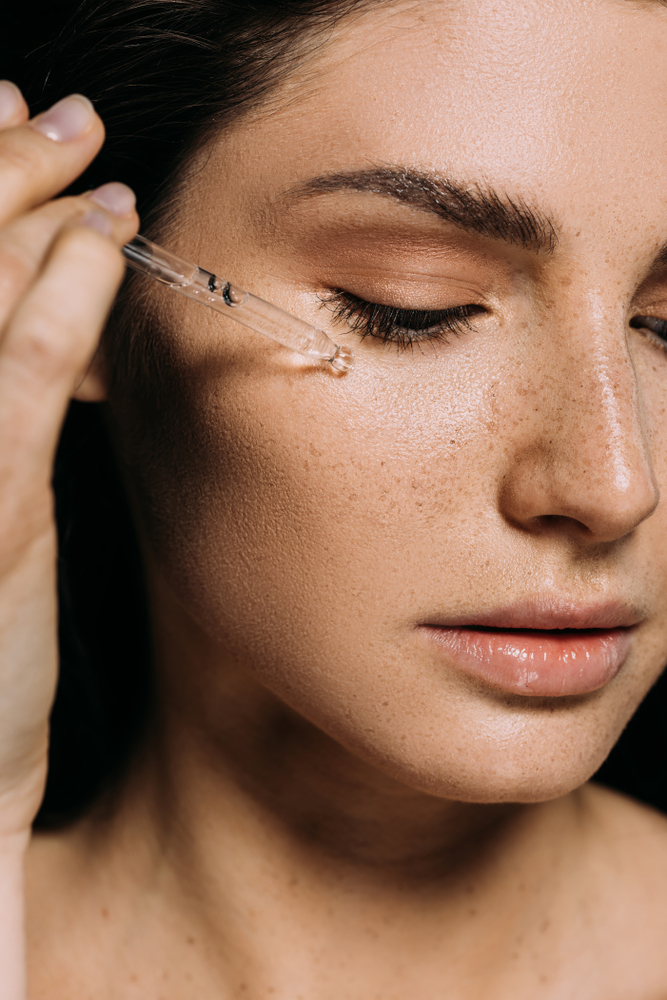IN PARTNERSHIP WITH CLEAR SKINCARE CLINICS

We all love a good active ingredient in our skincare — and when we require hydrated, firm, and glowing skin, lactic acid is our weapon of choice, particularly for sensitive skin.
Although our skin naturally replaces itself every 28 days, this process slows down as we age. This is where lactic acid, a common alpha-hydroxy acid (AHA), gets to work on the skin from the outside in, gently exfoliating the dead skin cells that dull our skin.
To make sure you’re getting the most out of your lactic acid in your skincare routine, here’s everything you need to know about this highly coveted skincare solution.
What is lactic acid?
When used in skincare, lactic acid is a by-product of fermented sugar and starch in sour milk. It’s also a compound that builds up in your muscles during intense exercise and is present in foods like dairy and vegetables as a by-product of fermentation.
How does lactic acid benefit the skin?
With sun exposure and age, the skin’s process of shedding old skin cells and replacing them with newer ones gradually slows down. The result is dead skin cells that tend to hang on longer, making your skin appear older.
When you use lactic acid, it hydrates the skin while physically loosening the structure and substances that hold skin cells together. The process prompts the skin’s outer layer, called the epidermis, to shed the dead cells that make your skin appear dull.
A celebrated AHA, lactic acid provides a powerful yet gentle exfoliation to soothe and nourish the skin. It softens texture and lines, calms redness and restores hydration. As a result, the skin it reveals looks newer, healthier, and appears to have a more even texture. Over time, lactic acid will also encourage collagen and elastin production.

How do you add lactic acid to your skincare routine?
Lactic acid comes in all different skincare products, including cleansers, serums, toners and in-clinic treatments. How you incorporate it into your skincare routine is a personal preference — and it works well with hydrating ingredients like hyaluronic acid. Still, it’s best to avoid other exfoliants and retinol.
When getting started with this powerful AHA, you should gradually introduce it into your skincare routine every few days. Once your skin has built up a tolerance, you should use lactic acid no more than once daily, and preferably at night to avoid immediate exposure to the sun.
The new lactic range from Clear Skincare Clinics is one way to achieve an even and dewy complexion. We recommend the Clear Skincare Gel Cleanser with Lactic Acid, an everyday and gentle cleanser to exfoliate and purify skin without irritating or dehydrating the complexion. And the Clear Skincare Lactic Acid Serum is a must have product to increase cell renewal, soften skin texture, and calm redness — all while maintaining moisture and strengthening the skin barrier.
If you’re after a bit of pampering or a heavy-hitting treatment, we recommend an in-clinic lactic acid peel.
Lactic acid vs other acids
Lactic acid differs from other acids because the molecule is larger, meaning it doesn’t penetrate the skin as deeply. Instead, it provides a surface treatment that works to polish, firm and exfoliate.
Those with sensitive skin will tolerate its effects better because it’s less likely to irritate and disrupt the pH balance of your skin, like with glycolic or salicylic acid.
If you’re someone with acne-prone skin that needs a deeper exfoliation, you can alternate your use of lactic acid with something more intense like salicylic acid, which will clear dead skin and deep clean your pores.
Ultimately, we love lactic acid because it can improve the appearance of ageing skin, fine lines, and pigmentation.
For more information on lactic acid or to treat yourself to an in-clinic lactic acid peel, visit clearskincareclinics.co.nz.










